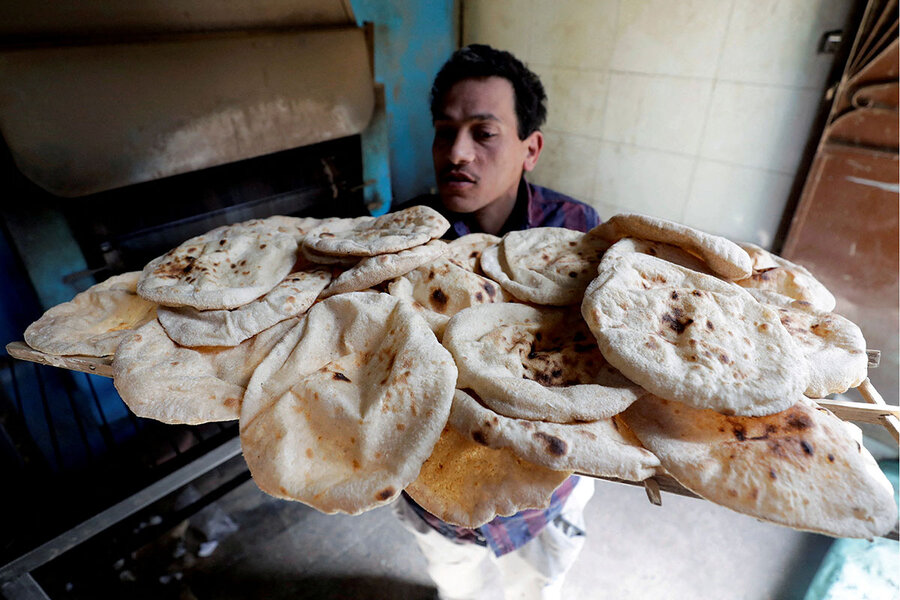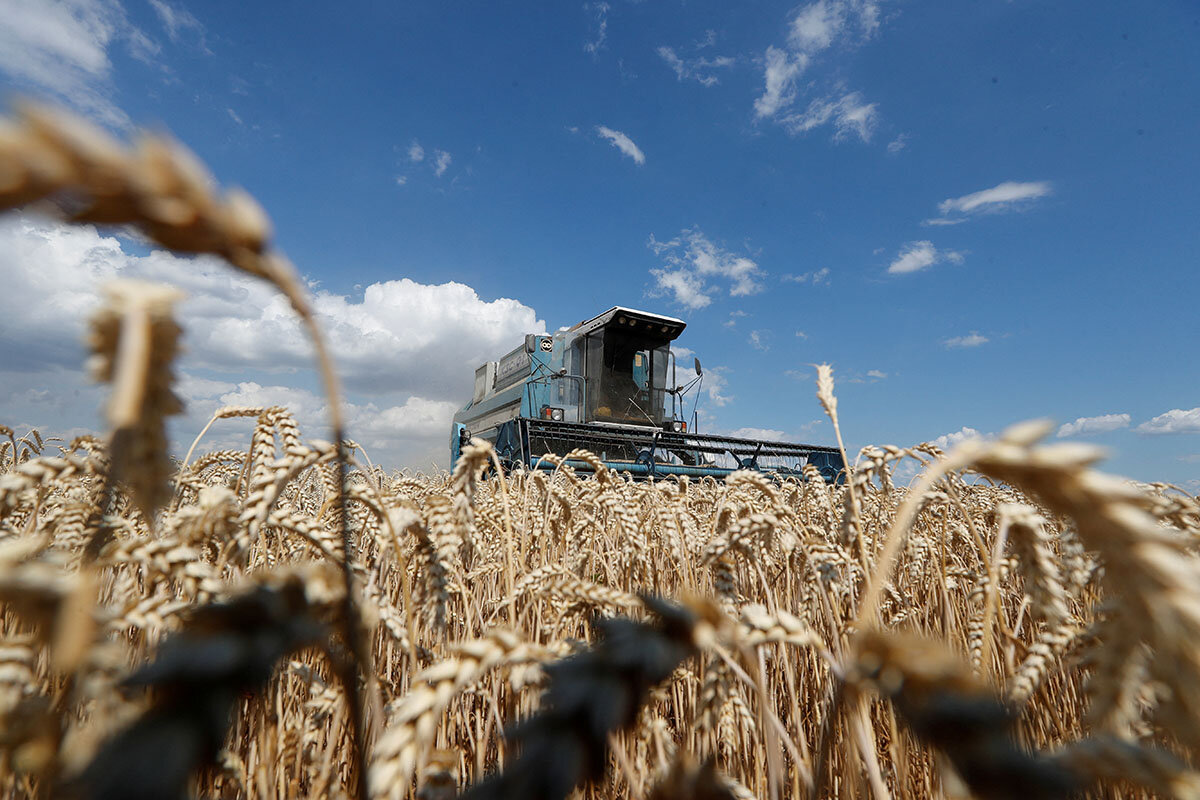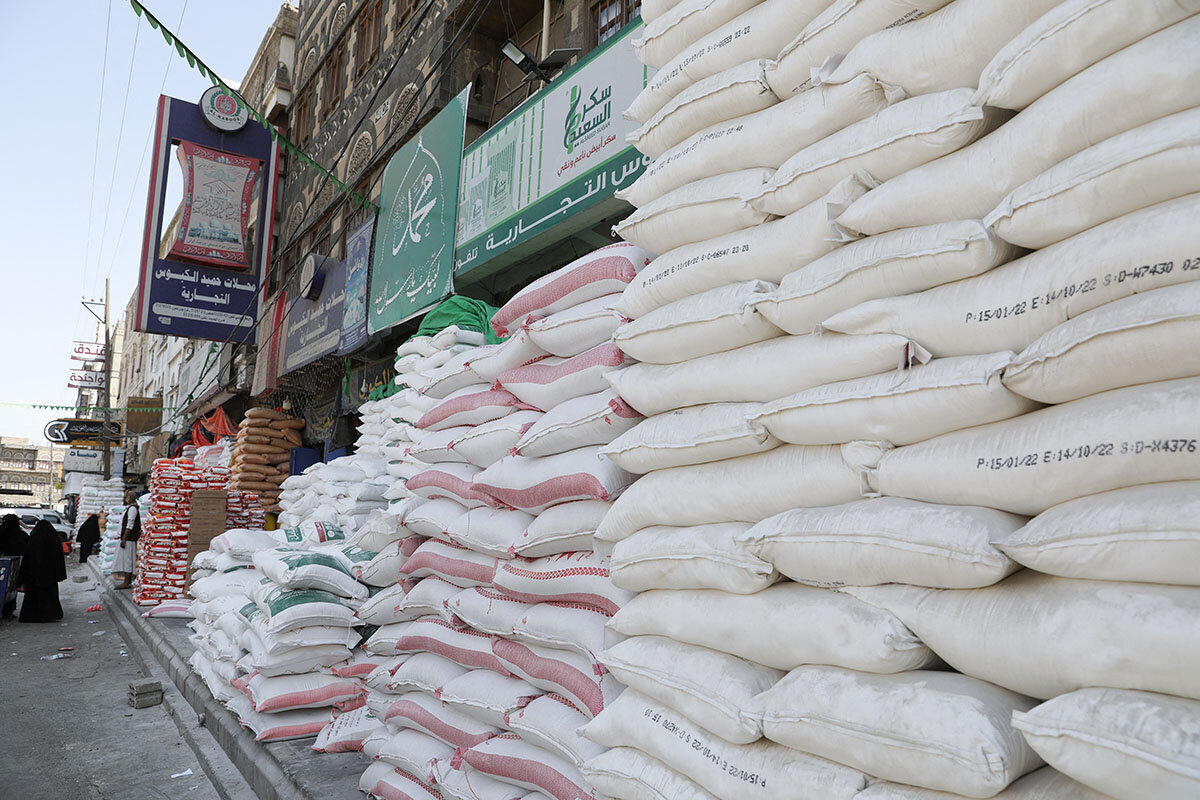How war in global breadbasket threatens food security everywhere
Loading...
When Ukraine banned the export of wheat this month and started scattering land mines in fields of winter cereals and sunflowers to slow invading Russian troops, it was bad news for Egyptian families struggling to put food on the table.
Egypt, which counts on Ukraine and Russia for half its food imports, was already facing food supply disruptions and high prices as a result of the COVID-19 pandemic and climate-related production losses.
But now Russia’s war in Ukraine has sent prices of grains and cooking oils even higher in Cairo markets – a trend that if sustained could put new strains on Egypt’s social fabric.
Why We Wrote This
The test of resilience posed by Russia’s war in Ukraine is radiating out from the Black Sea region, a global breadbasket. The challenge to other exporters: avoid protectionism that could worsen food insecurity.
“Global food inventories before the war were already very low, even lower than in 2007-2008, when we had the last big food-price crisis,” says David Laborde, a senior research fellow in markets, trade, and institutions at the International Food Policy Research Institute in Washington.
“Now we have this war in what is the breadbasket for North Africa and the Middle East,” he adds. “And while we’re not going to have famine in Egypt, we could see unpredictable and destabilizing consequences across the region.”
Egypt provides just one example of what it could mean for the world – and especially countries that are already food insecure – to find Ukraine’s vaunted breadbasket suddenly empty. Ukraine provides about 12% of the world’s wheat – 15% of global maize exports – with the Middle East and Africa receiving about 40% of Ukraine’s wheat and corn exports.
Global food powerhouse
Over the past two decades Ukraine and Russia have together made the Black Sea region a global food powerhouse, accounting for nearly 30% of global wheat exports. Some 26 countries now depend on the two countries for more than 50% of their grains and oils, according to the United Nations Food and Agriculture Organization (FAO).
Indeed, in the sweep of modern history, Ukraine’s transition from the “Holodomor” – the forced mass starvation at the hands of Soviet Russia in the 1930s that killed an estimated 3.5 million Ukrainians – to a major purveyor of global food security is an astounding example of human progress.
Now Ukraine’s sudden, war-induced withdrawal from global food supply chains, as well as stalled grain exports from Russia, have experts warning of a new round of food insecurity and debilitating price hikes reminiscent of the food-price crisis that accompanied the global financial meltdown of 2007-08.
They note that the two countries are also major exporters of agricultural fertilizers. Ukraine’s disrupted fertilizer production, along with war-related sanctions on Russian farm products, will raise farmers’ costs globally and eventually contribute to food-price rises.
What those experts are hoping to see is other major food-producing countries pitching in by maintaining or even increasing their export stocks, and avoiding protectionist measures. And so far global trade analysts say they are encouraged by an absence of any significant imposition of food export controls that countries may employ to tamp down their own food prices.
Risk of political instability
Still, the comparison to the last food-price crisis has government agencies including the Pentagon on the lookout for a rise in food-related conflicts and social instability – particularly in places where the United States has significant national security interests, such as in Egypt.
“I certainly see the risk of heightened political instability if we start to see protests over rising prices of staple foods,” says Caitlin Welsh, director of the Global Food Security Program at the Center for Strategic and International Studies (CSIS) in Washington.
“That’s what we saw in Egypt in 2010, when the price of bread was a contributing factor to the uprising that led to the overthrow of [President Hosni] Mubarak,” adds Ms. Welsh, who directed the National Security Council’s global economic engagement in the Obama White House.
Yet, while no one anticipates food-price protests sweeping across developing countries in the short term – many countries including Egypt have at least modest food subsidies to cushion rising prices – a more immediate concern is the impact that skyrocketing food prices will have on humanitarian aid efforts to countries already experiencing heightened food insecurity, such as Yemen, Afghanistan, and South Sudan.
“Disruptions in food supplies and these significant price hikes will really affect food in countries where people were already struggling, and will push more people in the world’s hunger hotspots into hunger,” says Julie Marshall, senior spokesperson for the U.N.’s World Food Program.
For example in Yemen, which in recent years has relied on Ukraine for nearly a quarter of its wheat imports, the recent volatility in food markets has added to the conflict-torn country’s already precarious living conditions. The number of Yemenis requiring food assistance has recently jumped to 17.4 million from 16 million last year – with WFP forecasting that nearly 2 million more Yemenis will become dependent on food assistance in the second half of the year.
In the meantime, WFP has, over recent weeks, added Ukraine to its list of countries requiring emergency food assistance. The organization has quickly ramped up to provide bread to 60,000 people a day in Kharkiv and high-energy bars to 30,000 people in Kyiv. Noting WFP recently supplied 450 tons of wheat flour to operating bakeries to produce bread, Ms. Marshall says, “Before they were the breadbasket of Europe, but now we are there handing out bread.”
A need for new funding
Already WFP, which forecasted requiring $19 billion in 2022 to feed 145 million people, is facing a 50% funding gap. “Some of our major donors” like the U.S., Germany, and Canada “are stepping up, but others are tapped out,” she adds.
That has WFP turning to new funding sources, like the world’s billionaires and the global public – notably by putting the organization’s affable executive director, former South Carolina Gov. David Beasley, on social media platforms.
One big question mark hovering over global food markets concerns how long the Ukraine war lasts and how damaged the country’s agriculture-export infrastructure – grain silos, fertilizer plants, port facilities – ends up once fighting ceases.
Ukrainian farmers who haven’t left their fields to go fight or haven’t had their farms destroyed “are putting Ukrainian flags on their tractors even in areas occupied by the Russians” as a gesture of defiance and are getting out to their fields, Taras Dzoba, Ukraine’s deputy minister of agrarian policy and food, told a Washington conference organized by CSIS last week.
“But for sure there will be much less spring planting,” he added, noting that “even if the war ended tomorrow” Ukrainian farmers might be able to plant 8 or 9 million hectares, whereas last year they planted more than 50 million.
And Ukraine’s food-export infrastructure is suffering heavy damage, with reports of Russian bombs hitting the country’s grain silos.
Mr. Dzoba, speaking from Kyiv, said Ukraine’s booming meat-export sector has been devastated. “We have lost chickens, we lost pigs, we lost beef – and this will spill over to other countries and affect their economies.”
Challenge to producing countries
Ukraine’s MHP, the world’s sixth-largest poultry exporter before the war, has shifted to meeting needs at home – giving away hundreds of tons a day of chicken meat as security conditions permit.
Food security experts say that as important as stepped-up funding for rising humanitarian needs will be in the coming months, perhaps even more critical will be keeping the world’s food and fertilizer markets free of protectionist, my-country-first reactions.
“Globally the most important thing will be avoiding the temptation for producing countries to slap additional export restrictions on food and fertilizer,” says Mr. Laborde, the researcher. Beyond that, he’d like to see international initiatives to assist farmers in countries – in sub-Saharan Africa, for example – that simply can’t afford the shock of steep fertilizer price hikes.
Deputy Minister Dzoba says that even as the world acts to help his country, he hopes the international community extends the same sense of solidarity to other “fragile” countries as it addresses global food insecurity.
What the world must avoid now, he says, is allowing the example of “a more powerful state’s ... invasion of its neighbor” to “encourage countries to change their plans [and] to work more inside, instead of with everyone outside.”








